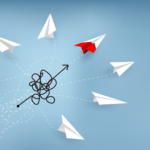Let’s take a closer look at ten common innovation methods, detailing each method’s advantages, disadvantages, and specific applications.
1. Design Thinking
Description: Design Thinking is a user-centered approach to solving complex problems. It involves five phases: empathy, definition, ideation, prototyping, and testing. This method encourages iteration, multidisciplinary collaboration, and rapid experimentation.
Advantages:
- User-centered approach ensures solutions are truly relevant to end-users.
- Promotes interdisciplinary collaboration, enriching the creative process.
- Iterative process allows for continuous improvement and adaptation to user feedback.
Disadvantages:
- Can be time-consuming due to the need for multiple iterations.
- Deep user engagement required can be difficult to achieve.
2. Lean Startup Method
Description: Developed by Eric Ries, the Lean Startup method focuses on developing products or services in short cycles to test hypotheses and learn from customers. It’s based on the “build-measure-learn” concept, encouraging startups to quickly launch minimal versions of their products to gather data and pivot if necessary.
Advantages:
- Enables market ideas to be validated quickly and efficiently, minimizing risks and expenses.
- Promotes continuous learning and flexibility, essential in uncertain environments.
Disadvantages:
- Risk of focusing too much on rapid iteration at the expense of long-term vision.
- Frequent pivoting can disorient the team and stakeholders.
3. SCAMPER Method
Description: SCAMPER stands for Substitute, Combine, Adapt, Modify, Put to another use, Eliminate, and Reverse. It’s a questioning technique that helps generate innovation ideas by examining an existing product or process from different angles.
Advantages:
- Provides a systematic framework for idea generation, facilitating creative thinking.
- Simple to understand and apply, suitable for various complexity levels.
Disadvantages:
- Ideas may require additional evaluation to determine their feasibility.
- May lead to incremental improvements rather than true disruptive innovations.
4. Blue Ocean Strategy
Description: Developed by W. Chan Kim and Renée Mauborgne, the Blue Ocean Strategy suggests creating new market spaces (“blue oceans”) where competition is minimal, instead of fighting in saturated “red oceans”. It involves redefining market boundaries to create new demand and make the competition irrelevant.
Advantages:
- Opens significant growth perspectives by creating new markets.
- Encourages companies to innovate in their offerings, increasing their unique value proposition.
Disadvantages:
- Identifying and developing a “blue ocean” can be complex and risky.
- Requires substantial resources for market research and product development.
5. TRIZ
Description: TRIZ is a problem-solving methodology based on analyzing patents and innovations to identify universal problem-solving principles. It’s based on the idea that many engineering problems have already been solved in other fields.
Advantages:
- Provides systematic solutions based on proven patterns.
- Helps overcome mental blocks and technical contradictions.
Disadvantages:
- Can be complex to master without specific training.
- Less suited to non-technical problems or rapidly changing environments.
6. Brainstorming and Brainwriting
Description: Brainstorming is a group technique for generating a large number of ideas quickly. Brainwriting is a variant where participants write down their ideas to avoid group dynamic issues.
Advantages:
- Easy to organize and execute, allowing for broad participation.
- Stimulates creativity and rapid idea generation.
Disadvantages:
- Quality and feasibility of ideas can vary widely.
- Group dynamics can influence freedom of expression and creativity.
7. Six Thinking Hats by Edward de Bono
Description: This method involves thinking about a problem from six different perspectives, symbolized by different colored hats, to explore all facets of a situation comprehensively.
Advantages:
- Allows for a thorough exploration of problems and solutions.
- Reduces conflicts by separating ego from the perspectives.
Disadvantages:
- Requires a good understanding of the method by all participants.
- Can feel artificial and constrain spontaneity in idea generation.
8. Jobs to be Done (JTBD)
Description: JTBD focuses on the “jobs” that customers aim to accomplish using a product or service. This approach aims to understand users’ deep motivations and the outcomes they seek to achieve.
Advantages:
- Offers deep insights into the real needs of users.
- Can reveal hidden innovation opportunities by identifying unmet or poorly met needs.
Disadvantages:
- The in-depth user research required can be costly and time-consuming.
- May require specific expertise to interpret and effectively apply insights.
9. Analogies and Biomimicry
Description: This approach involves looking for solutions found in other industries or nature to solve problems. Biomimicry, in particular, seeks to emulate strategies found in living organisms.
Advantages:
- Stimulates creativity by looking beyond the usual domain
- Can lead to radical innovations by applying proven principles in a new context.
Disadvantages:
- Translating solutions from one domain to another can be complex.
- Requires extensive research and sometimes interdisciplinary expertise.
10. C-K Theory (Concept-Knowledge)
Description: C-K Theory is an innovation management framework that distinguishes “Concepts” (unstructured ideas) from “Knowledge” (structured knowledge). It proposes an iterative process for exploring the concept space and enriching the knowledge space, fostering the creation of innovative ideas.
Advantages:
- Provides a structure for navigating between exploring abstract ideas and applying concrete knowledge.
- Encourages systematic exploration of new possibilities beyond current knowledge boundaries.
Disadvantages:
- Can be abstract and conceptual, making practical application challenging without proper training.
- The process can be perceived as complex and difficult to integrate into existing workflows.
Each method offers unique tools and frameworks for approaching innovation. The choice of the most suitable method depends on specific objectives, company culture, and the type of problem to solve.












About The Author
Janus Andersen
Advice on Strategy | Innovation | Transformation | Leadership Helping growth strategies and M&A transactions for 20 years